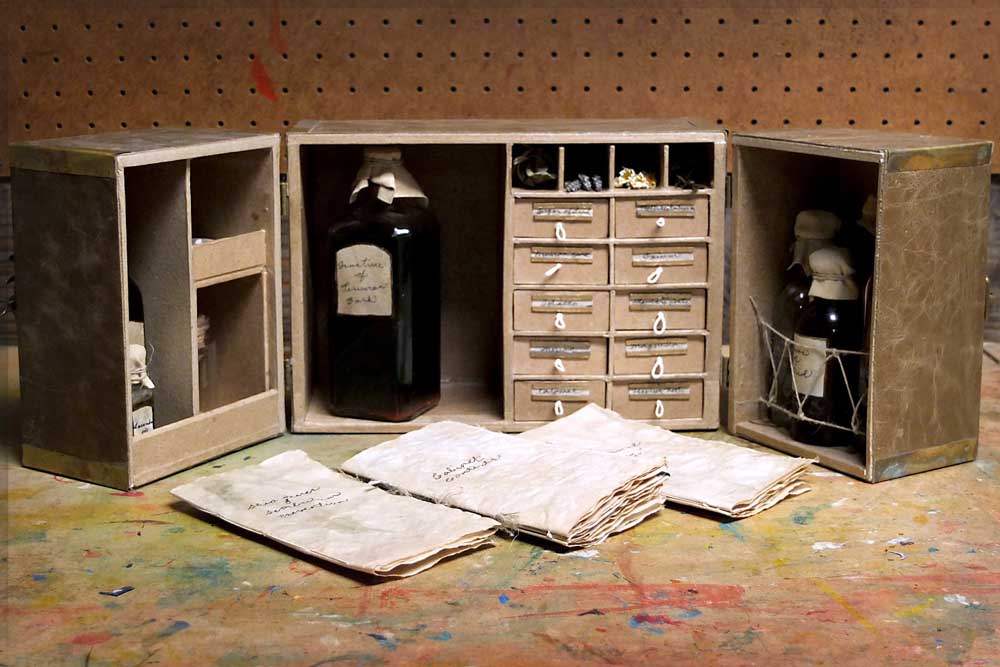Paper maker Astoria artist Christine Trexel creates exquisite books and boxes from plants in her garden
Published 3:00 am Thursday, December 8, 2016

- An imaginary apothecary for a 19th century ship by Christine Trexel.
Christine Trexel opens her door, and I walk into her home. Instantly I’m surrounded by three dogs. They were rescued from the streets of Panama, Trexel tells me. It seems they enjoy getting regular meals but crave the outdoor activity that Astoria’s weather often makes impossible.
Trexel is a paper and fiber artist. In her case that means she makes paper and uses it to create remarkable books and boxes. Her work will appear in a show of fiber arts at Astoria’s Imogen Gallery that opens from 5 to 8 p.m. during Astoria’s Second Saturday Art Walk Dec. 10.
As we walk to her studio she tells me that she retired from a career as an occupational therapist and that she and her husband Clark once lived in Australia before retiring to Panama. Hence the dogs. “We lived there for six and a half years,” she tells me. “We liked living out of the country and wanted another adventure.”
We arrive at her tidy studio (I say this as one who has seen a lot of artist’s studios), and there I meet one of the cats. He has a regal look about him, as though in another life he was an Egyptian court cat. He clearly runs things here, and he begins to take liberties with my hand as I attempt to take notes.
It was almost 20 years ago that Trexel became interested in bookbinding. “I took a class at Portland Community College, and I loved it,” she says. She continued taking classes at the Oregon College of Arts and Crafts, where she first tried her hand at making paper. “It really opened up my creativity, There’s something very satisfying about making paper.”
Trexel’s papermaking took off while she was in Panama, where she found the perfect plant fibers: papyrus (her favorite), torch ginger, heleconia and the trunk of the banana tree. Today she finds her raw materials in her garden: “New Zealand flax, iris, crocosmia, anything that has a long parallel fiber,” she says.
She shows me her greenhouse where she soaks the plant fiber and then uses a machine to reduce it to pulp, the basis for her paper. It’s a light, airy space with a few leaks, but one that can be cold during the winter, so she restricts her papermaking to sunny days. The rest of the time she is creating books and objects from the paper — and what marvels they are.
Trexel begins to show me books with various kinds of binding. Crown binding, Coptic binding, section sewn, Japanese stab binding, and even a book in the form of sails for a driftwood boat. The contents of the books might tell a history through pictures and writing, or there might be drawings or geometric designs. Her attention to detail is remarkable.
Trexel’s paper boxes show the same exquisite workmanship. She makes elaborate jewelry boxes, but the ones that caught my attention were those stuffed full of things. “House of My Travels” contained mementos of her personal history. Another was a “Repository of Lost Things” for storing the things we lose: a single earring, scrolls representing lost memories and signs for our lost courage, our lost religion. My favorite was a diminutive trunk, an imaginary apothecary for a 19th century ship. It contained fake medicine and books on the diseases and medicine of time, as well as directions for using the box.
As I took my leave I wondered what would be in the show at Imogen — she was still working on new creations — but I was certain that they would be small, exquisite treasures. And just in time for Christmas.





